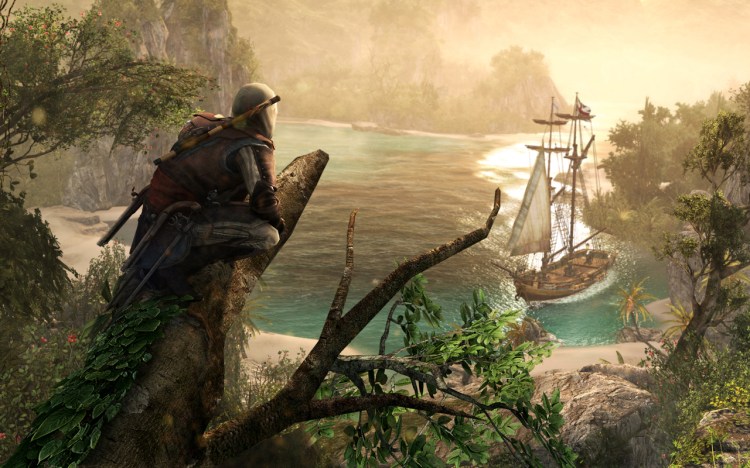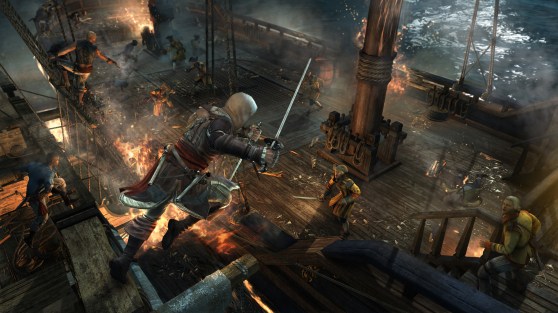It’s fair to say that the various development teams in Ubisoft have made each major release in their flagship franchise better than the one preceding it, and the progression from the first Assassin’s Creed to Assassin’s Creed IV: Black Flag has been stellar.
In fact, ACIV on PlayStation 3 and Xbox 360 is almost too ambitious for its own good. Although it handily delivers a rich, fresh adventure on the dangerous Caribbean Sea, this first release is just flawed enough that you might want to play it on next-generation hardware (or PC) instead.
What you’ll like
Sailing on the Jackdaw
Assassin’s Creed III simply didn’t have enough naval combat, but Ubisoft did the smart thing by making it a main focus in Black Flag. When you officially adopt your ship, The Jackdaw, the game’s world suddenly opens up.
While the controls could’ve stayed the same this time around, seafaring has really been refined with improved targeting and greater weapons variety. (Maxing out the upgrades on your swivel cannons basically makes you a wrecking machine.)
Interactions between ships are also amazingly seamless, and as a result, encounters never feel stale or cumbersome. A single change in weather can turn a simple pirating run into an all-out dogfight, and escalating battles with bigger ships can spell certain death when reinforcements enter the fray.
More than anything, the act of boarding an enemy ship is always a treat. As soon as you hook a crippled deck, the free-for-all fight to eliminate your remaining prey gives you plenty of variety, including shooting down military peons across the bow and diving from the ship’s rigging for air assassinations.
You really can’t avoid upgrading and maintaining the Jackdaw, either. As Edward Kenway and his crew steadily ramp up their activities across the seas, you’re eventually forced to explore a great deal of the game’s map just for the resources needed to keep up with enemy ships.
You’ll find treasure everywhere
It’s extremely difficult to get bored in Assassin’s Creed IV, and if it wasn’t for the inherent historical limitations, I would argue that this open world is just as engaging as Grand Theft Auto V’s.
No matter what you do in the game, you’ll have to constantly forage for money, materials, and resources to get ahead. That can involve anything from plundering a plantation to uncovering buried treasures, and ACIV is continually giving you new reasons to plumb the depths of each island’s surroundings.
Just about everywhere you look, you’ll uncover valuable assets: sunken shipwrecks, underwater caverns, smuggler’s hideouts, military forts, local taverns, dense jungles, and so much more.
Why don’t you just shoot him?
Despite not being a purebred Assassin, Captain Kenway is probably the most capable recruit that the secret order has ever seen.
Now that you can dual wield swords and freely shoot guns in third-person view, it’s hard to care about being stealthy about your kills anymore. With hidden blades, rifles, blow darts, and more, murdering enemies is almost sadistically fun.
Free-aim shooting also makes lots of potentially frustrating assassination attempts really easy, but your mileage may vary on how this affects the overall challenge. Personally, I didn’t mind the extra option one bit.
The big cities
If most fans could level one major complaint at Assassin’s Creed III, it would be that the American frontier wasn’t really the most thrilling environment for exploration. Save for the cliffs and dense stretches of forest, the landscape felt very flattened out while the settlements left a lot to be desired.
In contrast, Black Flag’s cities and islands are gorgeously laid out, with plenty of attention devoted to vertical space across several huge maps.
Between Havana, Kingston, and Nassau, you’ll get a little bit of architectural flavor from each of the core Assassin’s Creed titles, with each city paying homage to previous settings in the saga. Of course, they’re all dotted with plenty of activities to keep you busy between major missions, so good luck clearing each locale’s laundry list of riches and resources.



